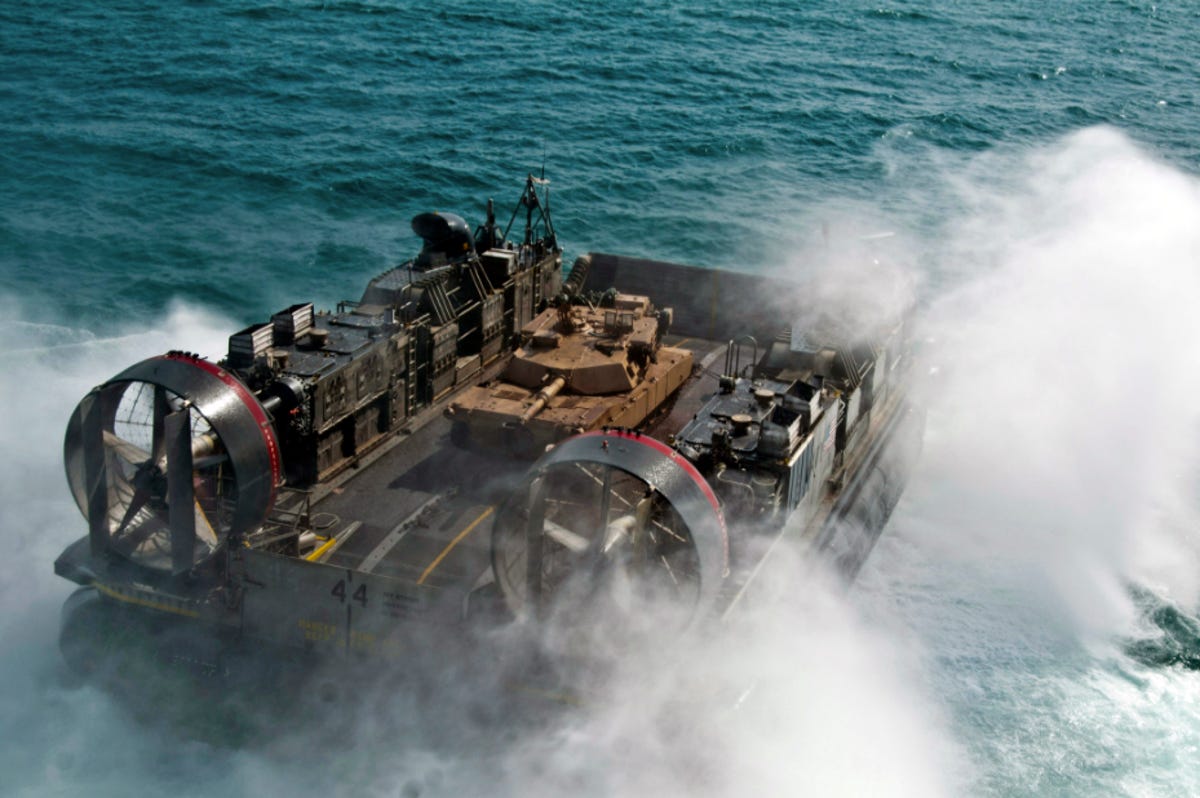The Navy's most advanced amphibious assault ship ever (pictures)
Commissioned late last year, the vessel is the Navy's only hybrid propulsion amphibious assault ship. Its electric drive and other systems saved the Navy $15 million in its first deployment.

Landing craft with tank
SAN DIEGO -- The U.S. Navy's newest amphibious assault ship is also its most advanced. Commissioned last year, the USS Makin Island (LHD 8) has a hybrid propulsion system -- with both electric and gas-powered drives -- that the Navy said saved $15 million during the craft's first, seven-month, deployment.
The Makin Island is 847 feet long and carries a crew of just less than 1,000 Navy sailors and about 1,200 Marines, and is equipped to carry out anything from combat to humanitarian missions.
In this photo, taken in the Arabian Sea, a landing craft air cushion leaves the Makin Island carrying an M1 A1 Abrams main battle tank.
As part of CNET Road Trip 2012, reporter Daniel Terdiman got a tour of the ship, and a firsthand look at many of its innovative systems.
USS Makin Island
The USS Makin Island carries a crew of about 2,200 personnel, and 29 helicopters -- 27 belonging to the U.S. Marines, and 2 belonging to the Navy. It also carries 6 Harrier airplanes (AV-8Bs), which can take off and land on the 847-foot-long flight deck.
Harrier landing
A Marine AV-8B readies for landing aboard the USS Makin Island, in this U.S. Navy photograph taken in the Arabian Sea. The vessel was assigned to the 11th Marine Expeditionary Unit, supporting maritime security operations and theater security cooperation efforts in the U.S. 5th Fleet area of responsibility, according to the Navy.
Helicopter landing
In this U.S. Navy photo, "a qualified landing signalman enlisted...gives training to another [Navy] sailor as an MH-60S Sea Hawk helicopter assigned to Helicopter Sea Combat Squadron 23 lands on the flight deck of the...USS Makin Island."
Maintenance of helicopters
U.S. Marines carry out maintenance on AH-1Z Cobra helicopters assigned to Marine Medium Helicopter Squadron 268 on the Makin Island's flight deck.
Marines and sailors
The crew of the USS Makin Island -- hundreds of Marines and Navy sailors -- lines up in this Navy photograph.
Takeoff
A Marine Harrier takes off from the USS Makin in this U.S. Navy photograph.
Supervising the controller stations
In this Navy photo, "Chief Air Traffic Controller Gavrila Brooks supervises the [Makin Island's] controller stations during flight operations" in the Pacific Ocean in June.
Bridge
A look at the bridge of the USS Makin Island from the flight deck.
Flight deck from 'Vulture's Row'
Just outside the ship's bridge is a lookout that allows anyone to view the flight deck without getting in the way. This is a view of the flight deck from the lookout, called "Vulture's Row."
Aircraft elevator
This is one of the Makin Island's two aircraft elevators. Though it doesn't have to move so fast, it can bring a helicopter or airplane up to the flight deck from the maintenance deck in about three seconds.
Ship control
Though the captain runs the ship, a young sailor is usually the one in charge of steering, which is controlled from this station on the bridge.
Primary flight control
A look up at the Makin Island's primary flight control area from the flight deck.
ESB control center
The Makin Island's entire engineering infrastructure -- its propulsion, water filtration, electric system, and so forth -- is run from this control center. But there are also dozens of workstations throughout the ship that can be used to control its propulsion, and switch between its electric and gas-powered drive systems.
Electric drive
Though not flashy to look at, this is the Makin Island's electric propulsion system, known as the auxiliary propulsion motor. Because it allows the ship to run without gas, the system -- the first aboard a U.S. Navy amphibious assault ship -- allowed the Makin Island to spend $15 million less on fuel during its first, seven-month, deployment than it could have.
The electric drive propels the Makin Island at speeds of up to 12 knots, or 13.8 miles an hour, about half the ship's top speed using its gas turbine engine. It also produces no additional emissions, and has no moving parts other than a rotor shaft.
Missile launchers
The Makin Island maintains a couple of "defensive" missile launchers, according to the Navy.
Miox system
This is the Makin Island's Miox system, which allows the ship to treat fresh water without the use of bromine or chlorine. This means the water can be put back in the sea without worries of pollution, and the system can also create a safe disinfectant that can be put in a bottle and sprayed on surfaces for cleaning.
Walter filtering membranes
In order to carry less water, the Makin Island has a water filtration system that relies on membranes to gradually convert salt water to potable water. Each of these tanks has a membrane, and the water is gradually put through each tank.
Gas engine
One of the Makin Island's two gas turbine engines.

